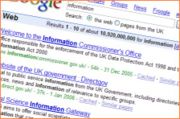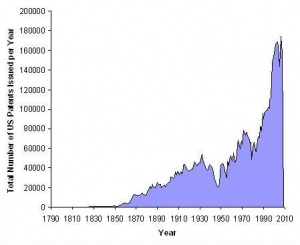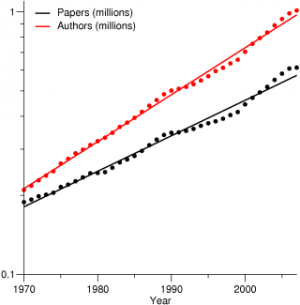Information
One significant aspect is that information can now completely describe the physical structure of man-made items, and can be communicated to automated fabrication machines which can then manufacture the product, reducing the requirement to transport material goods great distances to the end user, as happens generally now. Most of the journey will effectively be spent as information travelling at the speed of light. (See section on turning virtual designs into physical objects).
Accelerating information
Information tends to accelerate, as each generation builds on the work done by the previous one. Remarkably, the growth of information - measured many different ways - is often found to grow exponentially, not linearly. One estimate is that humanity doubled the amount of information it had gathered between 0 A.D. and 1500 A.D. (a doubling period of 1500 years). The next doubling of information took only 250 years, the next 150 years, the next 50 years, then ten years, then six years...
While it is impossible to be precise about the amount of information humanity has, it would be difficult for anyone to deny that our ability to extract data from the world is growing at an unprecedented rate.
This accelerative process has been called The Law of Accelerating Returns (by Ray Kurzweil), time-binding (by Alfred Korzybski) or "the jumping Jesus phenomenon" (by Robert Anton Wilson).As humans collaborate with one another across space, we can also collaborate across time. An engineer building a car nowadays incorporates in his project the cognitive work done by Isaac Newton hundreds of years ago. In this way we can draw on an ever-expanding pool of knowledge.
Alfred Korzybski  called this phenomenon time-binding
called this phenomenon time-binding  . He argues in Manhood of Humanity that humans have the unique ability to compound their knowledge generation after generation. Each generation inherits the knowledge of the previous one, adds its own and passes it on. In this sense, each generation has more sophisticated ideas to operate on than the previous one. Buckminster Fuller had a similar idea, which he simply called "know-how".
. He argues in Manhood of Humanity that humans have the unique ability to compound their knowledge generation after generation. Each generation inherits the knowledge of the previous one, adds its own and passes it on. In this sense, each generation has more sophisticated ideas to operate on than the previous one. Buckminster Fuller had a similar idea, which he simply called "know-how".



